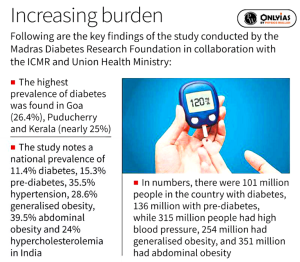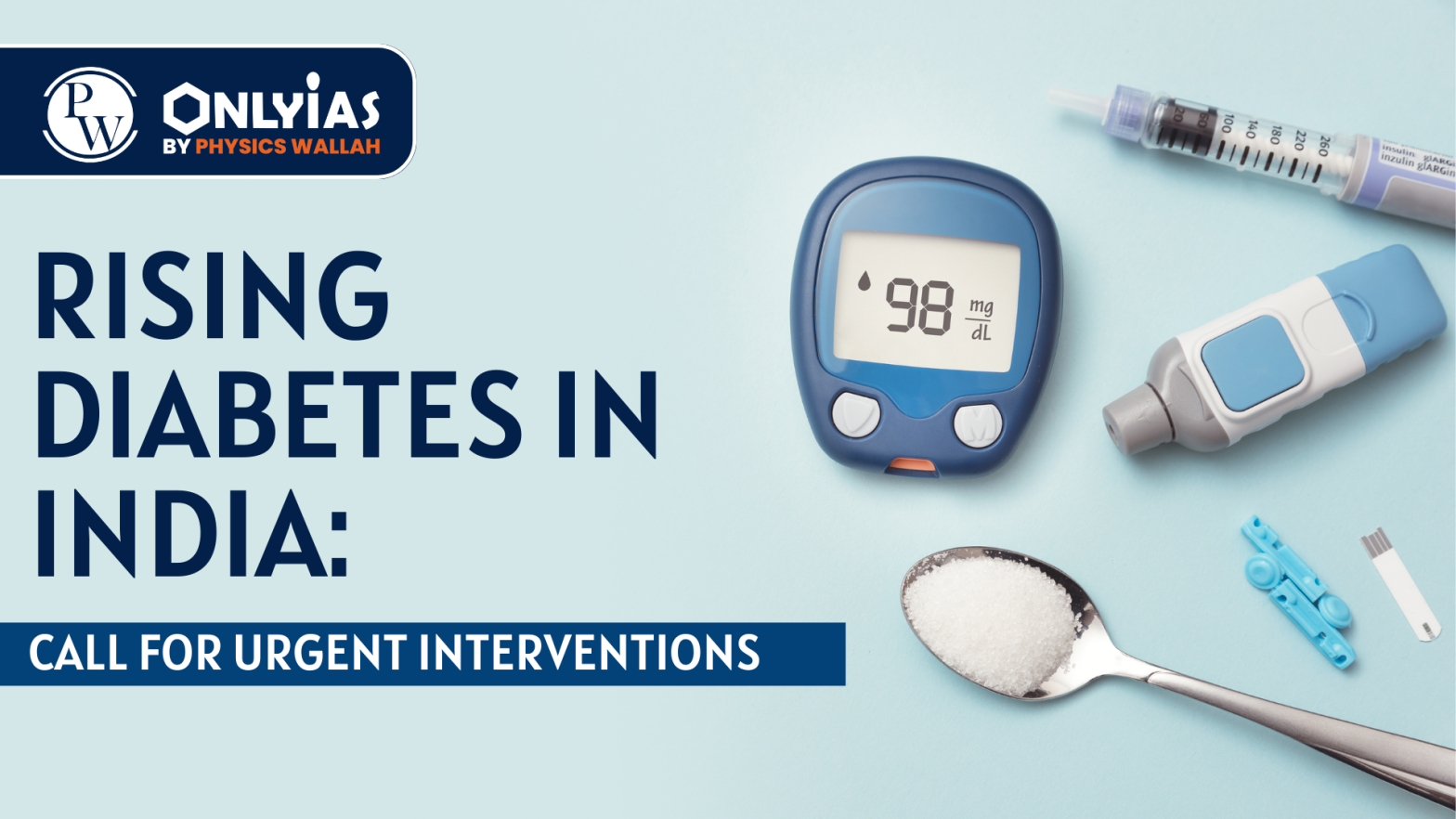Context:
| Relevancy for Prelims: Health, Diabetes, Type 2 diabetes, World Health Organization, Body Mass Index (BMI), Eat Right India, and FSSAI.
Relevancy for Mains: Diabetes concern in India, associated factors, challenges and required measures. |
Diabetes in India; A Statistical Overview
- Diabetics: 11.4% of India’s population or 10.13 crore people are living with diabetes

- Pre-diabetic: 15.3% of India’s population or an additional 13.6 crore people
- Obesity: 28.6% of India’s population would be considered to be obese as per the Body Mass Index (BMI) measure.
Obesity and Diabetes Threat
- Major Causal Factor: According to the World Health Organization, a major reason is the consumption of unhealthy ultra-processed foods and beverages.
- High Marketing: These unhealthy ultra-processed foods and beverages are aggressively marketed displacing traditional diets.
- Billions of rupees are spent on marketing and advertising that leads to increased consumption by vulnerable populations like children are exposed to cartoon characters and given incentives and gifts.
- Scientific Evidence: Scientific evidence shows that diets heavy with ultra-processed food and beverages or high in sugar, fat, and salt are risky and can lead to diabetes.
- Eat More, Risk More: When food is ultra-processed, its structure is destroyed and cosmetic additives, colors, and flavors are added, which makes people eat more, gain weight, and heightens the risk of diabetes and other chronic diseases.
- Concerning Data: A 10% increase in the consumption of ultra-processed food a day is associated with a 15% higher risk of type-2 diabetes among adults.
- A disease of High Risk: Obesity and diabetes are key risk factors for heart disease and death.
- Study shows that those who had more than four servings of ultra-processed food a day were much more at risk of cardiovascular mortality.
Also read: Diabetes Mellitus (DM) and Tuberculosis (TB) in India
Regulation Delay: Diabetes Threat Amidst Industry Influence
- Seeking for Loss Compensation: Such industries are now focusing on low- and middle-income countries, as the sale of sugar-sweetened beverages has fallen in many high-income countries, which makes India a playground for the food industry.
- Offer Partnerships for Unrestricted: The food industry does not want any restrictions on marketing and offer partnerships as well as arguments of economic development as ‘stakeholders’.
- Such partnerships do not allow for strong regulation that could reduce the consumption of ultra-processed food and beverages.
- Food & Health Awareness Programs: The food industry also participates in programmes such as ‘Eat Right’, making false promises.
- Playing a Dominating Role: The Food Safety and Standards Authority of India has shown a low response to the crisis and allowed a dominating role to the food industry while suggesting front-of-package labeling, which is still not in place.
Also read: Unveiling India’s Kidney Transplant Crisis
The Path Ahead
- Need of Legal Framework: The only way the government can safeguard people is through a legal framework or even an ordinance (Article 123 of the Constitution) with the objective of reducing/halting the consumption of ultra-processed foods.
- It need to define about the following:
- Healthy food
- A warning label on unhealthy food
- Restrictions on the promotion and marketing tactics of unhealthy food and beverages
- The people must be informed of the risk of consuming such food
- Need of Strict Regulatory Actions: Strong actions would be necessary on such policies.
- Learn from Others: The governments of South Africa, Norway, and Mexico have recently taken similar actions.
Conclusion
The alarming rise of diabetes in India, fueled by the pervasive influence of the food industry, necessitates urgent governmental intervention.
| Attempt the PY Prelims Question
Consider the following statements in the context of interventions being undertaken under Anaemia Mukt Bharat Strategy: (2023)
- It provides prophylactic calcium supplementation for pre-school children, adolescents and pregnant women.
- It runs a campaign for delayed cord clamping at the time of childbirth.
- It provides for periodic deworming. to children and adolescents.
- It addresses non-nutritional causes of anaemia in endemic pockets with special focus on malaria, hemoglobinopathies and fluorosis.
How many of the statements given above are correct?
- Only one
- Only two
- Only three
- All four
Ans: C |
![]() 6 Oct 2023
6 Oct 2023


